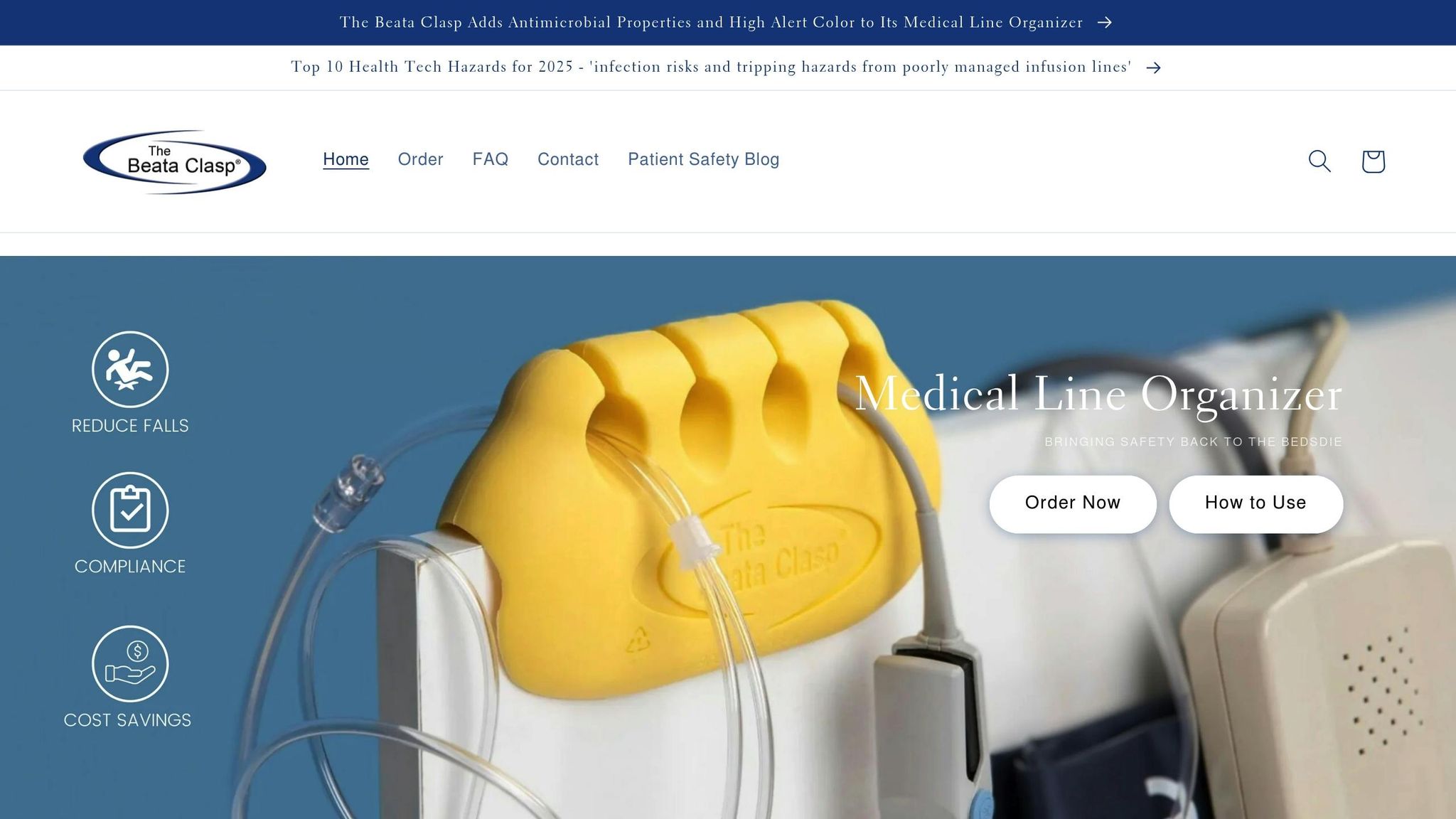Tangled IV lines are more than just a hassle - they can lead to serious risks like injuries, medication errors, and longer hospital stays. Nurses can prevent these issues by following simple, effective strategies for IV line management. Here's a quick summary of what you need to know:
- Organize your workspace: Use labeled tools like rake pole-tops and position IV poles strategically to avoid tangling.
- Label and secure lines: Use color-coded labels and stabilization devices to keep lines safe and easy to manage.
- Adopt daily routines: Perform hourly checks using the TLC+1 method to ensure lines stay organized and functional.
- Utilize tools like BeataClasp: This antimicrobial, latex-free organizer simplifies line management and reduces contamination risks.
- Train regularly: Staff training on IV management best practices ensures consistent care and minimizes errors.
These steps not only improve patient safety but also make workflows smoother for healthcare professionals. Read on for detailed tips and techniques to prevent IV line entanglement.
How to keep IV lines free of tangles #RN #nursingeducation
Setting Up Your IV Workspace
Keeping your IV workspace tidy is essential for patient safety and smooth operations. Research from a simulated ICU showed that using line labels and organizers, like a rake pole-top, significantly cut down on infusion identification errors compared to standard setups.
Placing IV Poles and Pumps
Here’s how to arrange your IV poles and pumps for maximum efficiency:
- Position IV poles where they won’t block patient movement or staff access.
- Use rake pole-tops (vertical organizers) to keep IV bags aligned with their pumps.
- Place frequently used lines closer to your workspace.
- Ensure enough space between multiple IV poles to avoid tangling.
- Use connecting bases to make transporting poles more stable.
Once your poles and pumps are in place, you can start prepping the individual IV lines.
Pre-Connection Line Setup
Prepare each IV line with these steps:
- Unpack and untangle all lines carefully.
- Check that the lines are compatible and the correct length.
- Group lines based on their purpose, such as medication or hydration.
- Place primary lines closest to the patient’s access point.
Using structured tools can help you keep everything in order.
BeataClasp Setup Guide

- Initial Placement: Attach BeataClasp organizers to key points on the bed rails. The material is flexible and antimicrobial, making it easy to position.
- Line Organization: Separate lines by type, using high-alert colors for quick visual identification.
- Verification Process: Trace each line from the patient to its source to ensure everything is routed correctly.
The BeataClasp works with different bed rail sizes and is compatible with standard hospital disinfectants. Its latex-free design aligns with hospital protocols and makes managing lines simpler and safer.
Daily IV Line Management Tips
Proper IV line management is crucial to prevent tangling and reduce errors, especially given the 53% error rate in IV administration. Here are practical tips for labeling, securing, and monitoring IV lines effectively.
Line Labeling Systems
Accurate labeling is critical, as over 58% of IV-related errors result from incomplete or incorrect labeling. To stay organized:
- Use color-coded labels that meet ASTM standards for IV bags and tubing.
- Clearly include the medication name, dose, concentration, and patient details.
- Apply tall man lettering for medications with similar names to avoid confusion.
- Select labels that can withstand exposure to alcohol and hand sanitizer.
Once labeled, ensure the lines are secured to further reduce risks.
Securing Lines Safely
Properly securing IV lines can significantly lower the risk of complications and tangling. A 2006 study found that stabilization devices reduced IV complications by 67%, cutting total complication rates from 48% to 16%.
Key tips for securing lines:
- Run tubing along limbs, following natural movement patterns.
- Use stress tape to prevent direct pulling if the tubing is snagged.
- Avoid taping on the proximal side of joints that flex.
- Never wrap tubing around fingers or toes.
- Keep access points visible and easy to reach.
Specialized stabilization devices that follow hospital protocols and are latex-free can also improve safety. After securing, regular checks are necessary to catch any issues early.
Line Check Schedule
Routine monitoring ensures IV lines remain organized and any problems are addressed quickly. The TLC+1 method is a simple way to perform hourly checks:
| Check Component | Action Required |
|---|---|
| Touch | Feel for warmth, swelling, or tenderness. |
| Look | Check for redness, leakage, or other visible issues. |
| Compare | Note any changes from the previous check. |
| +1 (Engage) | Ask the patient about their comfort and any concerns. |
These checks should be done hourly, including overnight. Caregivers can also assist by:
- Keeping IV sites visible at all times.
- Watching for signs of discomfort.
- Ensuring access points remain dry.
- Alerting staff if they notice any issues.
sbb-itb-f779e18
Using BeataClasp for Line Organization
BeataClasp builds on standard IV line management techniques to help prevent IV line entanglement, reducing risks like infections and falls.
BeataClasp Features
Made from styrenic thermoplastic elastomer, BeataClasp focuses on improving patient safety and workflow:
- Antimicrobial additives to support hygiene
- Latex-free material suitable for all patients
- Flexible yet durable design for repeated use
- Compatible with hospital disinfectants
- Bright colors for easy identification of lines
How to Use BeataClasp
To get the best results, follow these steps when using BeataClasp:
| Step | Action | Note |
|---|---|---|
| 1. | Secure to bed rail | Ensure it’s stable |
| 2. | Sort compatible lines | Keep lines separated |
| 3. | Disinfect | Use approved cleaners |
| 4. | Inspect regularly | Monitor for wear or damage |
These steps are designed to fit smoothly into your daily line management routine.
Results with BeataClasp
BeataClasp offers practical benefits for both patient care and nursing workflows:
- Minimizes fall risks by keeping lines organized
- Prevents IV dislodgement
- Reduces contamination by replacing adhesive tape
- Saves time with easier line management
This system works well in both single and multi-patient environments across various healthcare settings. Each unit costs $19.95, with bulk orders of 25 units available for $467.50.
Staff Training for Line Management
Effective staff training plays a critical role in ensuring patient safety and preventing IV line issues like entanglement. By focusing on key skills and procedures, training helps maintain high standards of care and minimizes risks associated with IV line management.
Training Topics
| Topic | Key Components | Frequency |
|---|---|---|
| Fundamental Skills | Hand hygiene, aseptic technique, barrier precautions | Monthly |
| Line Management | Securing methods, labeling systems, BeataClasp usage | Quarterly |
| Risk Prevention | Site assessment, identifying complications, emergency response | Bi-annual |
| Documentation | Digital tracking, incident reporting, compliance checks | Monthly |
Simulation-based training has been shown to reduce hospital stays and lower treatment costs.
Standard Procedures
To ensure consistency across staff, these standardized practices should be followed:
-
Mandatory Competency Assessments
Conduct annual reviews to ensure staff maintain their skills in IV line management. These assessments should include hands-on demonstrations with tools like BeataClasp and other necessary equipment. -
Risk Assessment Protocols
Use automated checklists to evaluate key patient and treatment factors, helping to identify and address risks effectively. -
Documentation Standards
Implement digital tracking systems to monitor IV line placement, maintenance schedules, and any complications. This ensures accurate record-keeping and compliance.
Updates and Refreshers
Regular updates are essential to keep staff informed about the latest practices:
- Quarterly skills reviews and monthly team meetings for hands-on practice and addressing challenges.
- On-demand digital learning modules for flexible training.
- Annual competency verifications to maintain high standards.
A study involving 108 ICUs in Michigan found that combining consistent staff training with standardized procedures led to a 66% reduction in catheter-related bloodstream infections over 18 months.
To maximize participation, schedule small-group sessions during off-peak hours and track completion through digital systems.
Conclusion: Preventing IV Line Tangles
Keeping IV lines organized is crucial - studies show over 60% of ICU incidents can be avoided with better management.
Quick Tips for IV Line Management
| Area | Key Actions | Impact |
|---|---|---|
| Workspace Setup | Arrange IV poles and organize pumps strategically | Lowers the chance of tangled lines |
| Line Labeling | Clearly label tubing at insertion points and connections | Reduces medication errors |
| Daily Management | Trace lines and perform regular checks | Prevents misconnections |
| Safety Protocols | Use proper hand hygiene and aseptic techniques | Cuts down infection risks |
These steps align seamlessly with the design and functionality of BeataClasp.
"The single most important work practice solution for clinicians is to trace all lines back to their origin before connecting or disconnecting any devices or infusions." - Joint Commission
How BeataClasp Helps
BeataClasp builds on these best practices to make IV line management easier and safer. Data highlights the importance of proper line organization, as incidents can cause physical injuries in 56% of cases and extend hospital stays in 23%.
Here’s what sets BeataClasp apart:
- Antimicrobial and secure: Helps prevent contamination and reduces fall risks.
- Simplifies workflows: Eliminates line tangles, saving time.
- Consistent management: Works across different departments and settings.
- Latex-free: Safe for all patients, including those with allergies.
Clinical evaluations show BeataClasp boosts both patient safety and nursing efficiency, making it a valuable tool for ICUs, hospitals, and even home care.
